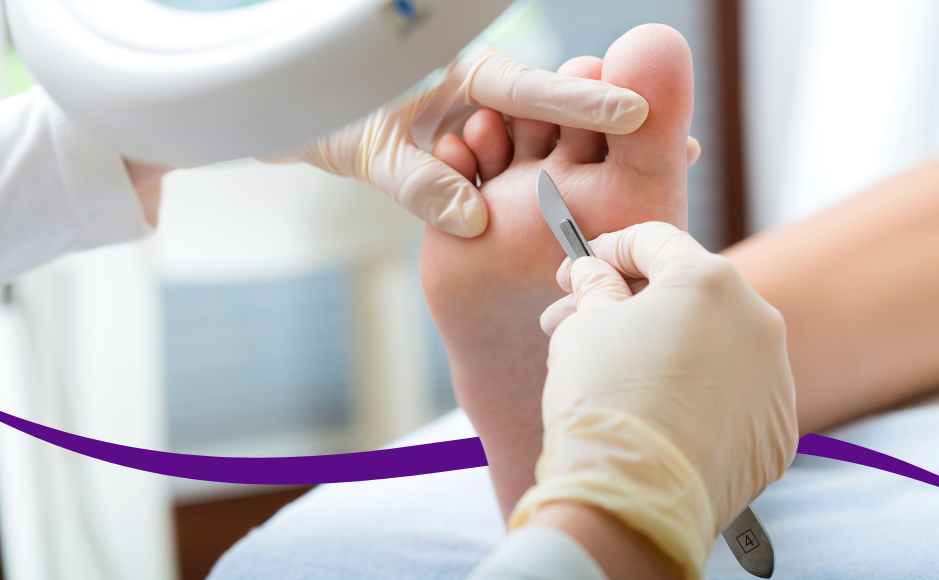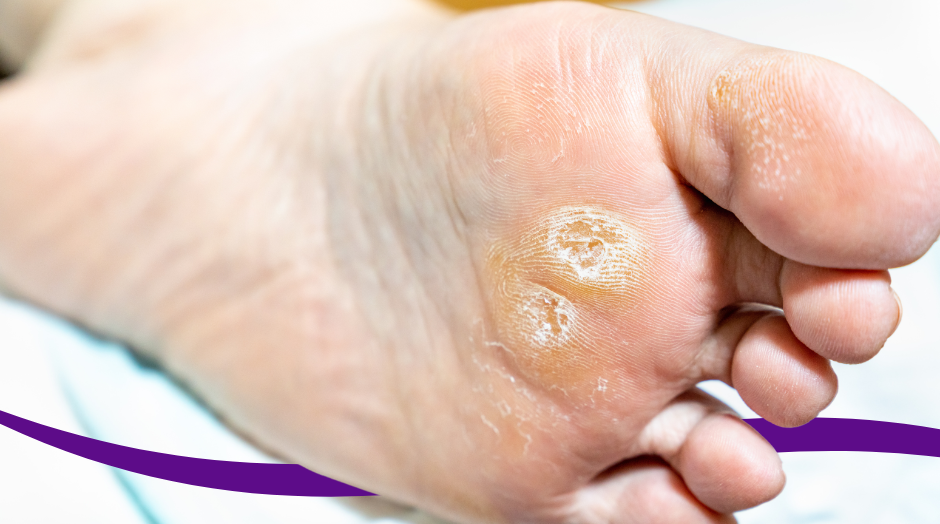

At first glance, warts and corns can appear strikingly similar. Many patients, and even some health professionals who are less familiar with
the unique characteristics of corns and warts, often confuse the two, leading to unsuccessful treatments (and naturally, much frustration).
Since one is a living and growing tissue and the other is hard, dead skin, accurately identifying whether that lump on your foot is a wart or a corn is crucial for effective treatment. And if you know our podiatry team, you know that evidence-based treatment that supports optimal outcomes for our patients is extremely important to us.
So, how can you tell whether the lump on your foot is a wart or a corn so you can treat it appropriately? Here’s what you need to know and how our podiatrists tell them apart.
Before we help you identify whether you have a corn or a wart, there’s one thing we need to know: does callus cover the corn/wart? A callus is a layer of hard, dead skin that develops over an area of skin exposed to pressure or friction. Because both corns and warts can appear on weight-bearing areas of the feet that are under constant pressure, it’s very common for them to have calluses covering them. In this case, it can be difficult to tell the two apart without debriding the callus back. If you’re in this boat, then you need to have the callus properly removed for two reasons:
Plantar (foot) warts, medically known as verrucae, are caused by a virus that infects skin cells, creating living, growing tissue. Warts have their own blood and nerve supply, making them painful and likely to bleed when cut. Here are the key features of warts that you may see after debriding any overlying callus:
Corns develop from repeated pressure or friction on a specific area of skin, resulting in hard, dead skin with no blood or nerve supply. There are no living cells, and they can’t spread to other members of the household like warts can. The good news? This makes them easy to remove with the right tools and without causing pain. After removing any overlying callus, corns exhibit the following traits:
Corns can be quickly and usually painlessly removed during a podiatry appointment, providing instant relief when you start walking. We do this as part of our skin and nail care appointments. Your podiatrist will use a small, sharp blade to circumscribe the corn and safely and effectively scoop it out. We estimate that one in two people who come in for skin and nail care have corns (often many), so this is something we are highly experienced in and treat all day, every day.
Warts, on the other hand, require more complex treatment due to their living tissue nature. You can’t just scoop them out without anaesthetic as you’d be cutting into living tissue, and it would be very painful, and falls under the category of wart removal surgery.
Our podiatrists offer four treatments with great results. Please note that while using chemicals (treatment options two and three) is clinically indicated for warts, it is not for corns. Misdiagnosing a wart as a corn and applying treatments like salicylic acid can damage healthy skin, leading to pain, redness, swelling, and discomfort. Always ensure you have the correct diagnosis from an experienced health professional.
Swift uses medical microwave technology that is highly effective in resolving plantar warts. Our podiatrists carry out the procedure, where
we have a special handpiece that sends focused microwave signals into the skin, targeting the wart cells without damaging the surface. This
unique approach causes the wart tissue to release proteins that trigger your body's immune response to fight and cure the virus. Throughout
treatment, your body also builds immunity to the virus, preventing future warts. This makes Swift different from other treatments that only
kill the wart without providing long-term protection. Our patients love Swift because there are:
Silver nitrate involves applying this gentle chemical to the wart tissue after any overlying callus and wart tissue have been debrided to expose the blood supply. This causes trauma, which helps kickstart your body’s immune system into action to attack and clear the wart.
Salicylic acid is a chemical often formulated into a paste-like substance, which is applied to the wart after it has been debrided (as
described above). Like silver nitrate, it reacts with the skin, creating tissue trauma in an attempt to activate the body’s immune
response.
Depending on the size of the wart and how long the infection has been present, you may require several treatments of silver nitrate or salicylic acid. Your podiatrist will discuss the specifics with you, but they will typically be applied every 1-2 weeks until the warts have resolved. In some cases, we encourage you to use an over-the-counter treatment in addition to these chemical treatments throughout your treatment period.
During the multiple puncture technique, your podiatrist uses a thin needle to repeatedly puncture the wart. This is done under local anaesthetic so that the procedure is painless, and works by pushing the infected cells into the deeper layers of the skin, so that an immune response is triggered, the wart is detected by the body, and the body gets to work on clearing the virus. As the recovery time is quicker compared to curettage (below), it is our preferred surgical method, if it is suitable for you. We have good success rates with the multiple puncture technique, with clinical studies showing a complete clearance rate of between 70% - 85%.
Curettage is a surgical procedure where a local anaesthetic numbs the area around the wart. Your podiatrist then removes the wart tissue to expose healthy skin. Phenol chemical is then used to burn the wart tissue, and silver nitrate is used to stem the bleeding. The success rate of this treatment is estimated between 65-85% in the research, which is in line with what we see in our clinic. Please note that this is an invasive procedure. During the first few days after surgery, you must stay off the foot as much as possible, as it will be tender with weight bearing. Most people walk normally within 1-2 weeks, by which pain tends to be significantly reduced or resolved.
Preventing corns involves reducing areas of excess friction and pressure on the feet. The best way to do this will be on a case-by-case basis as everyone’s foot type and activity levels are different, but wearing good, supportive footwear is a great start. Learn more about corns here. Preventing warts involves avoiding direct contact with the wart virus. Wearing footwear in public showers and pool areas and not sharing shoes and socks will help.
Yes, warts are caused by the human papillomavirus (HPV) and can be spread through direct contact or by touching surfaces contaminated with the virus. You can learn more about warts and how they spread here.
Warts may take anywhere from a day to several weeks to heal or resolve, depending on the treatment method chosen, the original size and location of the wart, your immune response, and your body’s ability to heal. Your podiatrist will provide you with the most accurate information at your appointment as we really can’t compare recovery following SWIFT (painless) with wart surgery, for example. Corns typically improve quickly with proper treatment and debridement. You should notice significant relief the moment you set your feet down.
If you have persistent pain, difficulty walking, or your wart or corn is causing you concern, see a podiatrist. A professional assessment
ensures proper diagnosis and treatment. Some people develop corns and warts on non-weight-bearing areas of their feet, and they don’t
bother them, so they choose not to have them treated.
| Monday | 7:40am - 6:00pm |
| Tuesday | 7:40am - 6:00pm |
| Wednesday | 7:40am - 6:00pm |
| Thursday |
7:40am - 6:00pm |
| Friday | TEMP CLOSED |
| Saturday | CLOSED |
| Sunday | CLOSED |
Ground Floor, 344 Queen Street,
Brisbane City QLD 4000
| Monday | 7:40am - 6:00pm |
| Tuesday | 7:40am - 6:00pm |
| Wednesday | 7:40am - 6:00pm |
| Thursday |
7:40am - 6:30pm |
| Friday | 7:40am - 5:00pm |
| Saturday | 7:40am - 4:30pm |
| Sunday | CLOSED |
Newmarket Village, 114/400 Newmarket Rd, Newmarket QLD 4051